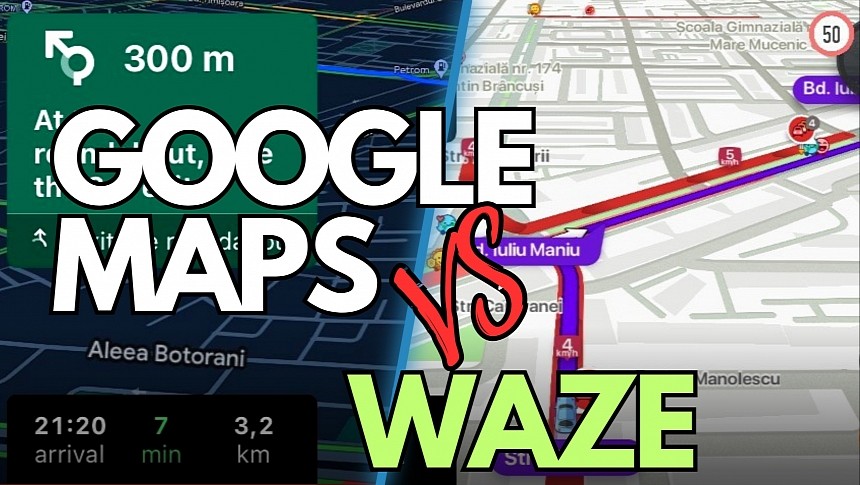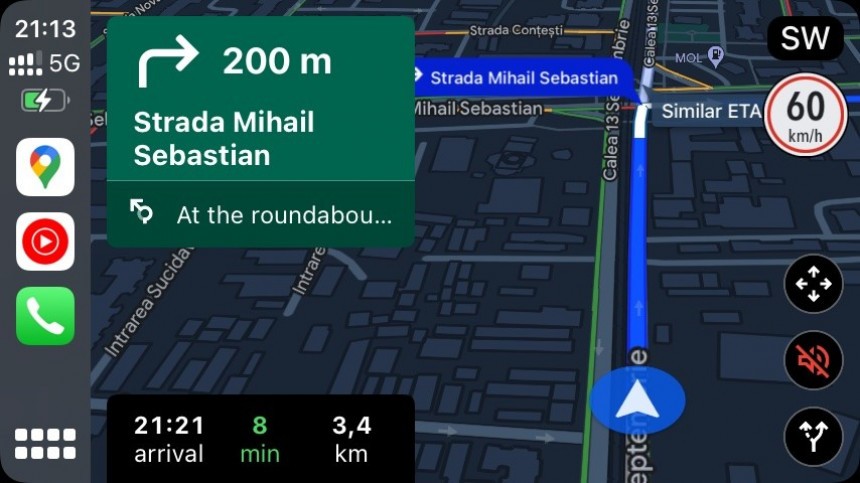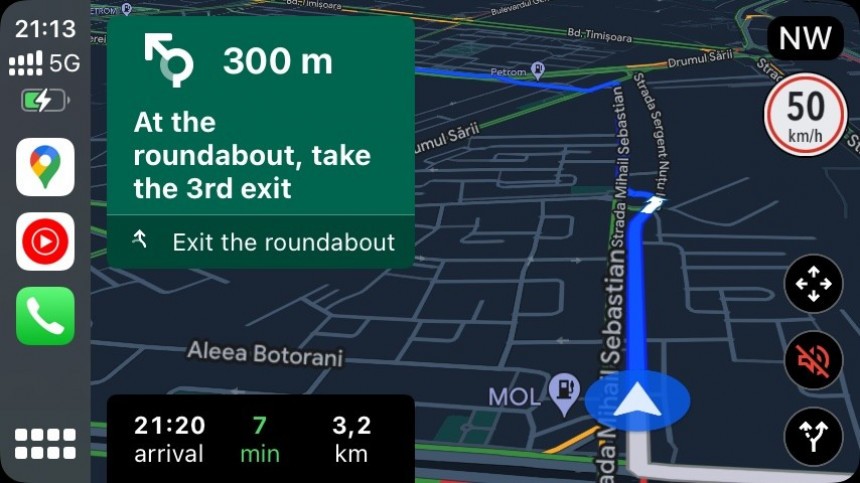Google and Waze dominate the navigation space on Android, Android Auto, iPhone, and CarPlay. Both are owned by Google and despite Apple devices coming with a pre-loaded in-house alternative, many people still install Google Maps and Waze on their iPhones.
The reason is simple. Google Maps and Waze are free and have advanced navigation features, allowing users to go from where they are to where they want to be easier, faster, and safer.
Many people believe Google Maps can replace Waze, and Waze can replace Google Maps. When something goes wrong, and they end up struggling with issues in one of these apps, they switch to the other and expect a similar experience and flawless navigation.
However, many users figure out the hard way that Waze can't be a replacement for Google Maps. Waze has a different focus, and while it can provide navigation to a defined address, it can't replace Google Maps full-time. Here's why.
First, Google Maps and Waze have different focuses. Google Maps is an all-in-one mapping platform, whereas Waze is all about traffic navigation.
Google Maps includes a top-notch navigation component but also offers great tools to explore the world, get walking directions, and check out stores for opening hours. Waze's only purpose is to find the fastest route to the destination, taking into account traffic conditions, accidents, broken traffic lights, and every other point where you could experience a slowdown.
It's one of the reasons Google Maps and Waze continue to remain side-by-side on the market. While many people believe Google Maps would eventually absorb Waze, as Google would merge the two apps and create an almighty navigation app, this isn't part of the search giant's long-term strategy.
As I explained earlier this year, Google wants to keep Google Maps and Waze on Android and iPhone specifically as it evolves Maps to an all-in-one platform. Waze would continue to serve as a traffic navigation solution, sometimes feeding traffic data into Google Maps.
Its crowdsourcing engine has evolved to become the main selling point, and Google knows that moving all users to Google Maps and convincing them to contribute with traffic reports is a major challenge. The Waze user base is varied and solid, which sets the application apart from the rest of the navigation crowd. Other companies have tried to copy the recipe, including Apple, but nobody managed to build a crowdsourcing engine at such a large scale.
While the different focus isn't obvious at first glance, the lack of features in Waze, when compared to Google Maps, is easily noticeable.
Waze doesn't come with offline navigation. It needs a permanent Internet connection to download and upload traffic data, find alternative routes, and provide users with real-time information as they head to the destination.
Waze also lacks other navigation modes, such as walking. Google Maps can offer step-by-step directions from a building to a parked car, guiding you beyond the driving experience. Therefore, it offers a complete navigation package, whereas Waze focuses entirely on the time spent behind the wheels.
Google Maps also offers extra features, such as eco-friendly routes. Launching in 2021, the eco-friendly routing engine allows users to navigate to a destination by cutting vehicle emissions and fuel consumption with a route specifically optimized for economy.
Waze is always looking for the fastest route to the destination.
As a long-time Waze user, I can truly say that I hate its cartoonish interface. Waze has barely evolved in terms of user experience and UI in the last few years, as Google's entire focus has been on improving Google Maps.
Waze feels outdated, cluttered, and sometimes annoying, especially because the default configuration includes unnecessary map items, such as chats (which are hardly useful, especially on Android Auto and CarPlay) and other Wazers. The application makes the interface feel heavy and confusing, and this is a big no-no, considering it should offer a clean design to let users get traffic information with a glance at the screen.
Google Maps offers a much cleaner approach, so the navigation experience is overall more straightforward. I'm not a big fan of the new colors, which sometimes make route guidance more confusing, but Google Maps is a lot easier to use than Waze, especially because of its clear instructions. Google Maps keeps the interface clean and simple, though the search giant sometimes throws unnecessary data at the user, too.
Overall, Waze can't be considered a Google Maps alternative, regardless of the platform. It can help you temporarily if you struggle with Google Maps and await a patch, but besides finding a faster route to the destination, Waze can't do much. If you want to navigate without an Internet connection, the only way to use Waze is to set up a route at home with a Wi-Fi connection and use the same route to the destination, as no further traffic updates would be downloaded.
Many people believe Google Maps can replace Waze, and Waze can replace Google Maps. When something goes wrong, and they end up struggling with issues in one of these apps, they switch to the other and expect a similar experience and flawless navigation.
However, many users figure out the hard way that Waze can't be a replacement for Google Maps. Waze has a different focus, and while it can provide navigation to a defined address, it can't replace Google Maps full-time. Here's why.
The different focus
Google Maps includes a top-notch navigation component but also offers great tools to explore the world, get walking directions, and check out stores for opening hours. Waze's only purpose is to find the fastest route to the destination, taking into account traffic conditions, accidents, broken traffic lights, and every other point where you could experience a slowdown.
It's one of the reasons Google Maps and Waze continue to remain side-by-side on the market. While many people believe Google Maps would eventually absorb Waze, as Google would merge the two apps and create an almighty navigation app, this isn't part of the search giant's long-term strategy.
As I explained earlier this year, Google wants to keep Google Maps and Waze on Android and iPhone specifically as it evolves Maps to an all-in-one platform. Waze would continue to serve as a traffic navigation solution, sometimes feeding traffic data into Google Maps.
Its crowdsourcing engine has evolved to become the main selling point, and Google knows that moving all users to Google Maps and convincing them to contribute with traffic reports is a major challenge. The Waze user base is varied and solid, which sets the application apart from the rest of the navigation crowd. Other companies have tried to copy the recipe, including Apple, but nobody managed to build a crowdsourcing engine at such a large scale.
The lack of features
Waze doesn't come with offline navigation. It needs a permanent Internet connection to download and upload traffic data, find alternative routes, and provide users with real-time information as they head to the destination.
Waze also lacks other navigation modes, such as walking. Google Maps can offer step-by-step directions from a building to a parked car, guiding you beyond the driving experience. Therefore, it offers a complete navigation package, whereas Waze focuses entirely on the time spent behind the wheels.
Google Maps also offers extra features, such as eco-friendly routes. Launching in 2021, the eco-friendly routing engine allows users to navigate to a destination by cutting vehicle emissions and fuel consumption with a route specifically optimized for economy.
Waze is always looking for the fastest route to the destination.
The childish interface
Waze feels outdated, cluttered, and sometimes annoying, especially because the default configuration includes unnecessary map items, such as chats (which are hardly useful, especially on Android Auto and CarPlay) and other Wazers. The application makes the interface feel heavy and confusing, and this is a big no-no, considering it should offer a clean design to let users get traffic information with a glance at the screen.
Google Maps offers a much cleaner approach, so the navigation experience is overall more straightforward. I'm not a big fan of the new colors, which sometimes make route guidance more confusing, but Google Maps is a lot easier to use than Waze, especially because of its clear instructions. Google Maps keeps the interface clean and simple, though the search giant sometimes throws unnecessary data at the user, too.
Overall, Waze can't be considered a Google Maps alternative, regardless of the platform. It can help you temporarily if you struggle with Google Maps and await a patch, but besides finding a faster route to the destination, Waze can't do much. If you want to navigate without an Internet connection, the only way to use Waze is to set up a route at home with a Wi-Fi connection and use the same route to the destination, as no further traffic updates would be downloaded.


















